Building Trust Through Cold Outreach: Strategies for Effective Relationship-Building
Share
In today’s fast-paced and highly competitive business landscape, establishing trust and building meaningful relationships is paramount to success. While networking events and referrals can be valuable sources for connecting with potential clients or partners, cold outreach remains an essential tool for expanding one’s professional network. However, the challenge lies in bridging the gap between a cold introduction and a genuine, trust-based relationship. In this era of digital communication, the boundaries of traditional networking have expanded exponentially, allowing professionals to reach out to individuals worldwide with just a few clicks. However, the sheer volume of cold emails, LinkedIn messages, and social media interactions can easily lead to a sense of impersonality and skepticism. To truly stand out and establish trust, it is crucial to adopt a thoughtful and strategic approach to cold outreach.
In this article, we’re going to discuss the top 5 impactful strategies for building trust through cold outreach emailing. These all strategies have been curated for you after conducting proper industry research.
So, let’s in.
What is Cold Email Outreach?
Cold email outreach is an effective method of initiating communication with potential prospects or clients who you don’t know. However, it can be challenging to establish trust and credibility in this initial contact.
Here’s an example:
A cold email outreach approach starts with a powerful introduction that should resonate with the prospect.
“Hey, I’m Christine, and I am a writer by profession. I love to contribute content, and I have a list of unique blog topic ideas for your blog readers.”
After the initial email, a follow-up email is the next step.
“Hey, it’s Christine again. I just wanted to share some interesting topic ideas with you.”
Next, the 2nd follow-up email should look like –
“Have you read my message” OR “Did you consider my offer…”
Then come to the 3rd follow-up and the final proposal – “Please let me know if you’re interested because after this email I might stop approaching.”
Importance of Trust and Credibility in Cold Outreach
Research by Harvard Business Review reveals that personalized, credible outreach efforts have a 50% higher response rate than generic messages. By leveraging trust and credibility, cold outreach campaigns become more effective in capturing the attention of recipients and initiating meaningful conversations. A survey by BrightLocal suggests that 91% of consumers read online reviews before making a purchase decision. By incorporating social proof, such as testimonials or case studies, in cold outreach messages, businesses can enhance their credibility and inspire confidence in potential clients.
Benefits of Cold Outreach Email
Some of the BIG advantages of using effective cold email outreach approach are:
1. Expands your network and connects you with potential clients or partners.
2. Helps you increase search engine ranking.
3. Cold emailing is part of an outreach marketing strategy that helps you connect with real people around the world.
4. Generates new leads and opportunities for business growth.
5. Permits you to showcase your expertise and establish credibility in your industry.
6. Facilitates direct communication and builds relationships with targeted individuals or companies.
7. Helps you stay proactive and take control of your outreach efforts to achieve your goals.
5 Impactful Strategies to Build Trust through Cold Emailing
#1 Know Your Target Prospect
#2 Use a Clear, Concise, and Confident Intro
#3 Use Open-Ended Questions to Alleviate the Prospect’s Pain Points
#4 Provide Social Proof To Validate Your Identity
#5 Be a problem solver and deliver value for free
#1 Know Your Target Prospect
According to a survey by HubSpot, personalized emails have a 26% higher open rate than generic emails. This highlights the importance of understanding your target prospects and tailoring your cold emails to their specific needs. Research conducted by MarketingDonut found that 92% of buyers are more likely to engage with personalized messages that demonstrate an understanding of their business challenges. By incorporating relevant details into your cold emails, such as recent achievements or industry challenges faced by the prospect, you can show that you have taken the time to research and are genuinely interested in their success.
#2 Use a Clear, Concise, and Confident Intro
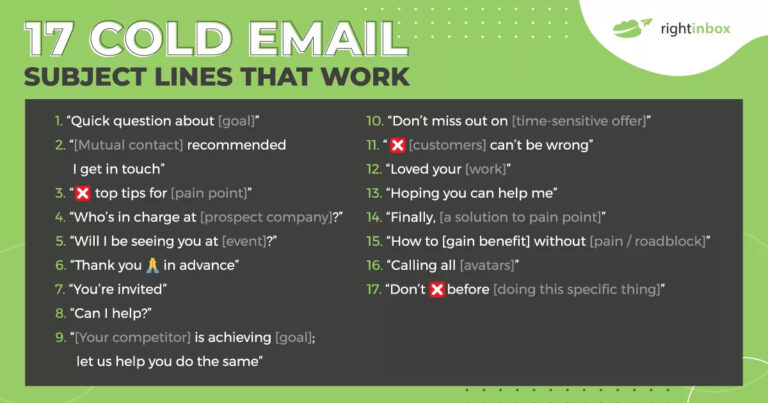
Image Source: rightinbox
In a study by Boomerang, it was found that emails with subject lines between 3 and 4 words had the highest response rates. This indicates the importance of concise and attention-grabbing introductions. Craft a clear and confident introduction that highlights your expertise, relevant experience, or successful track record. Avoid using generic or overly sales-oriented language, as it can come across as impersonal or insincere. Research reveals that personalized email subject lines have a 29% higher open rate than generic ones. Make sure that your content in email is grammatical or syntax error-free. You can use some powerful grammar checkers which are available online to make your process fast. By incorporating personalization and establishing a connection through shared interests or mutual connections, you can convey professionalism and build a foundation of trust from the outset.
#3 Use Open-Ended Questions to Alleviate the Prospect’s Pain Points
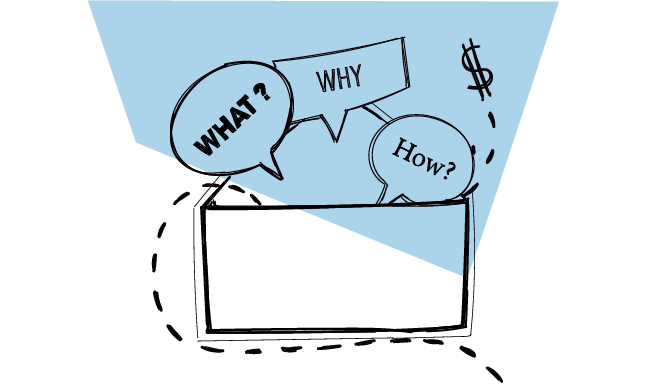
Image source: WoodPecker
According to research conducted by Gong.io, using open-ended questions in cold calls increased conversion rates by 15%. The same principle applies to cold email outreach. Pose questions that encourage recipients to reflect on their pain points or goals. By doing so, you show empathy and a genuine desire to help them overcome their obstacles. This approach fosters a sense of trust as the prospect feels understood and valued. Additionally, responding to these questions can initiate a dialogue and provide an opportunity to further showcase your expertise and offer valuable solutions.
What do the open-ended questions look like?
Here’s the example of some open-ended questions format you might use in your cold emailing:
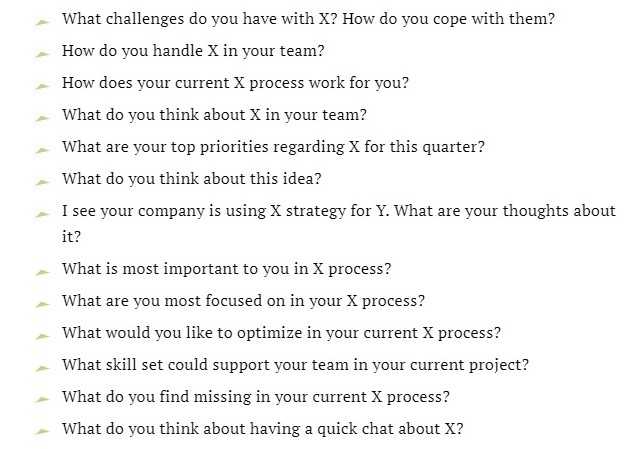
Image Source: woodpecker
#4 Provide Social Proof To Validate Your Identity
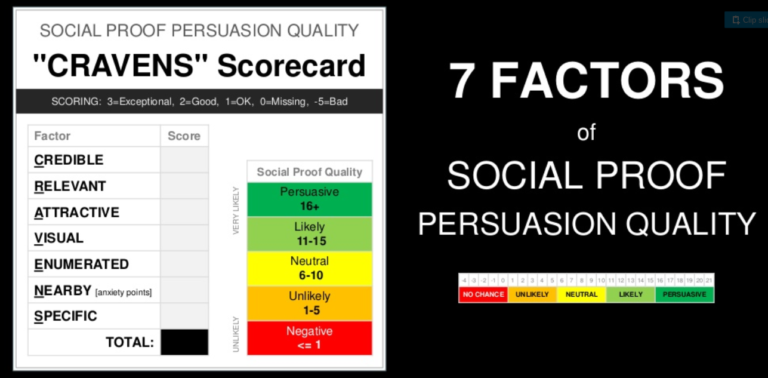
Image source: Prowly
BrightLocal conducted a study which revealed that 88% of customers believe online reviews are as reliable as personal recommendations. Including social proof in your cold emails enhances your credibility and reassures prospects of your legitimacy. Showcase positive testimonials, case studies, or client success stories. Highlight how your solution has positively impacted similar businesses or industries. By demonstrating that others have benefited from your offerings, you establish trust and increase the likelihood of a positive response.
Here’s is a great practical example Ryan Robinson, a blogger, received an email containing strong social proof:

Image Source: Prowly
#5 Be a problem solver and deliver value for free
Research from HubSpot indicates that 86% of buyers are willing to pay more for a better customer experience. To build trust and credibility, position yourself as a problem solver rather than a salesperson. Offer valuable insights, tips, or resources related to the prospect’s industry or pain points. For instance, share a blog article, industry report, or relevant statistic. By providing useful information without expecting anything in return, you establish yourself as a reliable source of expertise and genuinely interested in their success. This approach fosters trust and increases the chances of further engagement.
Here’s a perfect example:
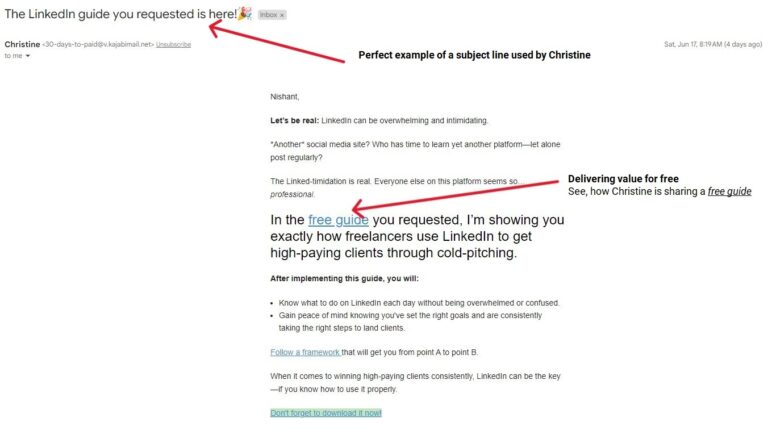
Image source: Gmail
Key Takeaways
1. Personalize your cold emails by conducting thorough research on your target prospects, demonstrating a genuine understanding of their needs and challenges.
2. Craft clear, concise, and confident introductions that grab attention and establish a connection through shared interests or mutual connections.
3. Use open-ended questions to engage prospects, show empathy, and initiate a dialogue to address their pain points.
4. Include social proof such as testimonials, case studies, or client success stories to enhance credibility and validate your identity.
5. Position yourself as a problem solver by providing valuable insights and resources related to the prospect’s industry or pain points, without expecting anything in return.
Final Thought
Cold email outreach can be a powerful tool when used strategically and with a focus on building trust. By implementing the strategies outlined in this article, supported by relevant statistics and reports, you can overcome initial skepticism and establish credibility with your prospects. Remember that building trust takes time, consistency, and a genuine commitment to adding value. By taking a thoughtful approach and focusing on building relationships rather than making quick sales, you can establish credibility, foster trust, and create meaningful connections through your cold email campaigns.

